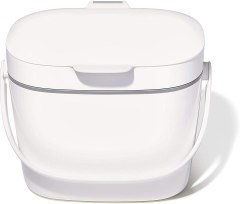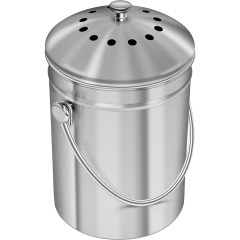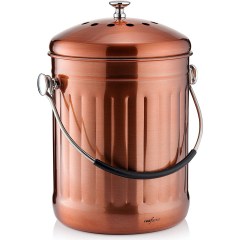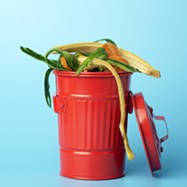Buying guide for best indoor compost bins
So much of what we use and consume on a daily basis can be repurposed in exciting and efficient ways, and that applies to what we eat and drink as well. Composting is a natural process by which organic matter can be recycled and reused, resulting in fertilizer that fosters plant growth. While anyone with a yard or garden may use an outdoor composting unit, popular indoor composting bins offer convenience and ease when discarding kitchen waste.
Indoor compost bins vary in size and often occupy space on the counter, accepting organized waste just as a recycling bin or garbage can would. A variety of models offer various means of control odor, although as our guide will explain, that’s something you can manage on your own as well.
Though relatively simple, indoor compost bins should cater to your lifestyle and needs, lest they become more of a hassle and burden than a benefit.
Key considerations
What is compost?
Compost is a collection of organic, nutrient-rich waste that can be used as fertilizer to help plants grow, cultivate a healthy lawn, or enhance potting soil. Compost may be made up of brown waste, such as leaves and branches, or green waste, such as fruit and vegetable scraps. Popular compostable elements include banana peels, grass clippings, nut shells, coffee grounds, eggshells, ashes, and even hair, fur, and lint.
Usage
Some people compost because it benefits their personal or communal garden. Others compost because they live in a city or town that collects compost, much like garbage and recycled items may be collected.
It may be helpful to think of your new compost bin as either a short-term or long-term receptacle. Depending on how you’re composting, you may prefer one or the other — or both. A short-term bin is a small receptacle used in the kitchen to collect waste that will later be added to a long-term bin. A long-term bin is a larger bin that requires more work and attention. You might store it outside or inside, and it may be part of your plan for a garden or part of a city or township collection effort.
Larger compost bins, when stored indoors, are often kept in a garage or shed. These bins are often called garden composters, and we cannot overstate their usefulness. However, in this buying guide, we are focusing more on the equally useful indoor bins that are smaller and usually found in kitchens.
Size
The average indoor compost bin holds around one gallon of material, or about 3.5 liters, though you can find bins that hold a half-gallon more or less. Consider your space when choosing; most people prefer to place their compost bin on the counter for easy access. Consider, too, how often you cook. If you cook a lot and anticipate filling the bin often, a smaller bin may become tedious with frequent emptying and cleaning. However, although a larger bin fills more slowly, the contents may rot and require frequent emptying anyway.
Material
Indoor countertop compost bins are often made of ceramic or stainless steel. While the material may influence durability, it’s unlikely to go through much wear and tear if you keep yours indoors and stationary. Plastic is also common, and while it can be colored to suit your taste, it may not hold up as well over the long-term.
In terms of décor, ceramic offers a contemporary, subtle look while stainless steel exudes a more industrial look. We have also seen compost bins made of bamboo for a natural aesthetic and compost bins made of copper and bronze for a rustic flair.
Though it may be unnerving to some, one method of indoor composting is vermicomposting, which involves using worms to convert the waste. This requires selecting the right worms, paying attention to what they eat, and even removing some after they breed.
STAFF
BestReviews
Features
Filter
Some indoor compost bins have a charcoal filter in the lid to help combat odor. With a filter in place, you might not have to empty the bin as often. Notably, the charcoal we’re talking about is not the same as the charcoal used in a fireplace or barbeque. (The latter can have adverse effects on the compost and soil!)
A filter must be changed every few months or so, depending on usage. Some compost bins come with extra filters to get you started.
Disposal
There are a few ways to empty a compost bin. Most bins have an external handle so you can simply carry the bin outside and dump it. Some have a separate insert that can be removed and disposed of. The insert is typically included to help combat odors; bins with more stylish exteriors often have them. The insert may have a slender metal handle that can be contained internally in lieu of a large external handle that may take up counter space. If you’re using compost bags as part of a disposal program in your city or town, an insert is likely unnecessary.
DID YOU KNOW?
Some consumers opt to place their compost bin in the freezer. This frees up counter space, slows down the decomposition rate, and greatly reduces harmful odors.
STAFF
BestReviews
Indoor compost bin prices
Inexpensive: Many smaller indoor compost bins cost $20 or less. These lack extra odor-controlling features but still serve their purpose.
Mid-range: Most indoor compost bins cost between $20 and $40. In this price range, you will find many options in terms of material, style, and size.
Expensive: The largest indoor compost bins, including those that actively fight odors and sport a certain style, usually cost $40 or more.
Compost that is balanced between green and brown material won’t produce much of an odor, but kitchen bins are not as likely to contain brown matter. Without leaves and twigs, excessive moisture and food scraps can create a foul smell.
STAFF
BestReviews
Tips
- Check city resources. Some communities offer compost pickup, which is especially useful for those living in apartments and yardless homes. The community may have a compost drop-off site as well.
- Open infrequently. When cooking a meal, place your scraps and extras in a bowl off to the side. Compost these all at once, when you have finished preparing your food. Opening the bin more frequently than that is tedious and allows odors to escape.
- Pare down your scraps. Even if your bin can accommodate larger pieces of food, it’s advised to chop them into small pieces, which will be more quickly and easily broken down by microbes and worms.
- Secure the lid. Make sure the lid is fully closed and secure when not open. This cuts down on odors, enhances composition, and detracts flies and curious rodents.
FAQ
Q. What are the benefits of composting?
A. By repurposing organic waste, you substitute a natural fertilizer for a chemical one. If you have a garden of your own, this reduces cost and waste while fostering plant growth. Nutrient-rich compost in your garden can effectively battle disease while retaining moisture, making long-term care easier.
Composting also means that your items won’t be going to a landfill, which helps reduce methane emission and your carbon footprint.
Q. What are some foods I shouldn’t compost?
A. If you are composting for a garden, avoid placing meat or dairy products in the compost. This will likely attract pests like rodents and flies, and it may also contribute to odor. The same is true for oils, fats, and lards. Some ash, like that from coal or charcoal, may contain harmful chemicals that can hurt plants. You’ll want to avoid composting pet waste as well, as it could contain harmful bacteria or germs.
If you're composting for a city or town pickup or drop-off, find out what is and is not acceptable. Depending on the process and machines used, certain items that might not be intuitive can be included in the disposal. Each town, community, and city will have its own guidelines and rules.
Q. How should I clean my compost bin?
A. Some indoor compost bins, like those made of stainless steel and bamboo, are dishwasher safe for easy and convenient cleaning. However, even if your bin is to be washed by hand, it’s a fairly easy chore. Use warm water and soap to fill the container, and wash with a scrub or brush. Thoroughly dry the bin before starting a new collection of scraps.

























